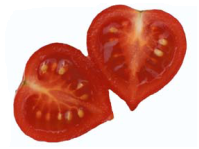Living Organisms are not Protectable by a Design in Europe: The Case of a Heart-Shaped Tomato
On February 13, 2013 the OHIM Third Board of Appeal issued a decision1 in which the position of the Examining Division, that a living plant or its fruit cannot be registered as a design, was affirmed. In particular, the Examining Division and the Boards of Appeal clarified that a living plant or its fruit do not meet the definition of a design in accordance with Article 3(a) CDR2 as a living plant or its fruit cannot be considered as a product within the meaning of Article 3(b) CDR.
The case under appeal pertained to a design application of a Dutch plant breeder by the name of A.C.J. Ammerlaan. The design application was filed in 2011 for a heart-shaped tomato in Locarno Class3 1.02 for Fruit and Vegetables. The application was refused by the Examining Division alleging that it did not comply with the definition of a design pursuant to Article 3(a) and 3(b) CDR.
 |
 |
Illustrations of the tomato for which the design was applied as presented in the Appeal Decision.
Article 3(a) and Article 3 (b) CDR define the meanings of “design” and the “product” on which it is applied as follows:
(a) ‘design’ means the appearance of the whole or a part of a product resulting from the features of, in particular, the lines, contours, colours, shape, texture and/or materials of the product itself and/or its ornamentation;
(b) ‘product’ means any industrial or handicraft item, including inter alia parts intended to be assembled into a complex product, packaging, get-up, graphic symbols and typographic typefaces, but excluding computer programs;
In the appeal, Ammerlaan argued, inter alia, that (1) the tomatoes are produced in a work-intensive process and are identical to each other; (2) the fruit may be regarded as a “product” as it is produced in an industrial process which results in the same shape; (3) nothing in Article 3(b) CDR implies that the product cannot be a living object, and that the protection is sought for the result of the products features, i.e. its appearance. Ammerlaan also attempted in its arguments to rely on the existence of several design registrations in Class 1.02, including a registration for a melon under RCD 549951-001, but the Boards of Appeal did not even consider these arguments.
The Board in its decision adopted an approach that living organisms, in particular their produce are not to be regarded as “industrial or handicraft item”, even if the shape of that organism differs from that of an “ordinary” organism. The Board noted that there is no evidence that the resultant shape of the living organism is obtained through an industrial or manual process rather than being a product of a “special plant” specimen. This assertion of the Board provides guidance for future applicants wishing to register a design for plants or plants’ produce who would be wise to submit evidence as to the unique and original appearance of the organism in case. Furthermore, the case may be strengthened by submitting evidence to show that the features for which the protection is sought are a result of an industrial or manual process.
1 Appeal Decision for Case R 595/2012-3; A.C.J. Ammerlaan, published in Dutch and only recently published in the OHIM’s Newsletter, 01/2014.
2 Community Design Rules
3 Industrial designs are classified in 32 classes according the Locarno Classification (LOC), established by the Locarno Agreement (1968), which is an international classification used for the purposes of the registration of industrial designs.
This article is provided for general information only. It is not intended as legal advice or opinion and cannot be relied upon as such. Advice on specific matters may be provided by our group’s attorneys.

